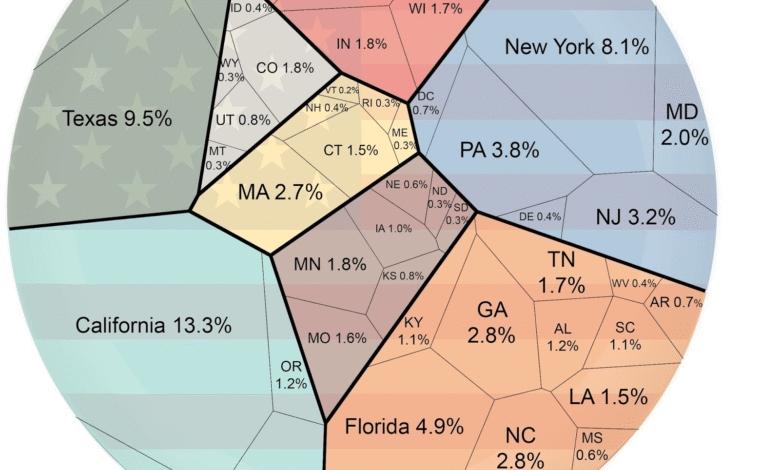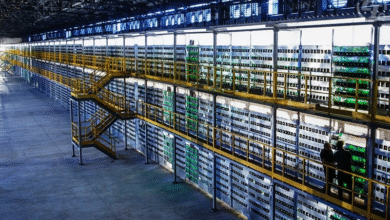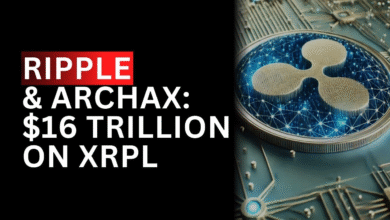US Economy Transition: Trump Acknowledges Recession Risks

The US economy is currently undergoing a significant transition, as President Trump navigates the complexities of economic growth amidst rising recession risks. In light of the recent US GDP report, which revealed a contraction of 0.3% year-over-year, concerns about economic stability have taken center stage. Trump’s America First policies, particularly the controversial tariffs, have been scrutinized for their potential adverse effects on the economy. While the President remains optimistic about the future, stating he believes in achieving the “greatest economy in the history of our country,” experts caution that the transition period may not be as smooth as anticipated. As discussions around the economy evolve, the dialogue surrounding Trump’s comments and approaches continues to shape perceptions of US economic resilience and strategy.
The current shift in the United States’ fiscal landscape reflects a critical moment in economic management, with discussions around potential downturns and growth strategies at the forefront. As the nation faces indicators pointing toward a possible economic slowdown, many are analyzing how recent policies are influencing overall economic health. The debate centers on balancing aggressive trade initiatives with the imperative for sustainable growth, as highlighted by the mixed signals from the latest GDP figures. With some analysts viewing this as a transitional phase for America’s economic identity, the interplay between policy and economic performance reveals a complex web of challenges ahead. The ongoing evaluation of how these strategies impact both short and long-term stability remains paramount in understanding the United States’ economic trajectory.
Understanding the Transition of the US Economy
The notion of a transitioning economy is pivotal in comprehending President Trump’s recent comments regarding the U.S. economy. A transition period often suggests a shift in economic dynamics, which could encompass changes in trade policies, consumer behavior, and overall economic management. As Trump characterizes the current economic situation as a major shift, it reflects a broader struggle for economic stability against the backdrop of America First policies that his administration has adopted. The tension between promoting domestic industries and the potential fallout from aggressive tariffs illustrates the complexities involved in this economic transition.
Amidst this transition, the U.S. economy is faced with various indicators that interplay with its growth trajectory. For instance, recent GDP reports suggest stagnation, hinting at the potential risk of recession amidst trade wars and tariff disputes. Trump’s assurances that the economy is poised for greatness must be taken with caution, especially as entities like JPMorgan indicate a rising probability of recession. Thus, while the U.S. economy is in a state of transition, the outcomes of this phase remain highly uncertain, influenced by both domestic policies and global market reactions.
Trump’s America First Policies and Economic Uncertainty
President Trump’s commitment to America First policies has undeniably influenced economic sentiment across the nation. His administration’s focus on reshaping trade agreements and imposing tariffs on foreign goods aimed to bolster American manufacturing and reduce trade deficits. However, the price for these strategies has come at a cost; many economists argue that such aggressive approaches have created volatility in the market, heightening recession risks. Critics have pointed out how these policies may have contributed to the disappointing GDP report that showed a contraction for the first time in eleven quarters.
The application of tariffs has sparked debates about whether they truly protect American industries or whether they foster economic instability. By taking a hardline stance on trade, Trump’s America First policies may inadvertently risk alienating key trading partners, which can provoke retaliatory measures. Analysts observe that while Trump’s vision promotes national interests, the associated economic turbulence raises critical questions regarding sustainability and growth. As the potential for a recession looms, the impacts of these policies on everyday Americans remain a central point of concern for both policymakers and citizens alike.
Analyzing the Risk of a Recession in Today’s Economy
The possibility of a recession has crept into national discussions, particularly following the recent negative GDP report. With forecasts from institutions like JPMorgan placing the likelihood of a recession at 60%, the alarm bells are ringing louder on Wall Street. Key factors contributing to this heightened risk include inflation, supply chain disruptions, and the lasting impacts of aggressive trade policies that have characterized the current administration. This economic climate prompts both consumers and investors to reconsider their strategies, leading to a more cautious sentiment towards spending and investment.
Moreover, the ongoing concerns about recession resonate beyond immediate economic indicators. They reflect a deeper anxiety regarding financial stability for both individuals and businesses. When economic momentum falters, consumers may tighten their wallets, leading to reduced demand for goods and services, which can create a detrimental feedback loop. President Trump’s assertion that he is unperturbed by recession risks contrasts sharply with the financial realities being faced by many, raising questions about the sustained effectiveness of economic policies meant to stimulate growth.
Impact of Trump’s Trade Policies on Economic Stability
President Trump’s trade policies have been a defining aspect of his economic agenda, framed under the America First narrative. However, the implications of these policies have sparked debate among economists, particularly regarding their long-term sustainability and impact on economic stability. Tariffs imposed on foreign goods were intended to curb imports and stimulate domestic production, yet they have also led to inflated prices for consumers and disruptions in supply chains, which fundamentally challenge economic stability.
Critics argue that such trade measures create an unstable environment, where businesses must navigate unpredictable costs and retaliatory tariffs from trading partners. Consequently, the very policies designed to protect American workers could be inadvertently exacerbating economic challenges and recession risks. As evidenced by the fluctuations in the GDP report and market reactions, the path to economic stability has become precarious, necessitating a reevaluation of the balance between protectionism and open trade.
The Role of Economic Indicators in Assessing Stability
Economic indicators such as GDP, employment rates, and inflation figures serve as critical tools for assessing the stability of the U.S. economy. The recent contraction in GDP, reported to be a decline of 0.3% year-over-year, sheds light on potential weaknesses within the economic structure. These statistics function not merely as abstract numbers but as vital signals reflecting consumer confidence, business investment, and overall financial health, all of which play a pivotal role in determining recession risks.
Furthermore, understanding economic indicators allows policymakers and financial institutions to devise strategies aimed at preventing downturns and promoting growth. As uncertainty looms over the economy, attention must be paid to these indicators to navigate through this transitional phase effectively. By closely monitoring trends and shifts within these metrics, the government can better prepare for future challenges, seeking solutions that foster recovery and sustainable economic growth.
What Does the Future Hold for the US Economy?
Facing the potential of a recession amid an economic transition, questions loom large regarding the future of the U.S. economy. President Trump’s optimistic assertions about achieving the greatest economy in history contrast with potential recession signals, leaving citizens and investors pondering what lies ahead. The need for clarity is paramount, as navigating the aftermath of negative GDP growth alongside rising recession risks continues to be a topic of heated debate—both politically and economically.
In evaluating the future, scenarios range from optimistic recoveries fueled by innovation and resilient consumer spending to more conservative views marred by ongoing economic challenges. The outcome will heavily depend on both domestic policy decisions and external economic forces. It is crucial for the U.S. to cultivate an environment conducive to growth, striking a balance between protectionist policies and international collaboration that can help mitigate recession risks and promote long-term economic stability.
Economic Responses to Policy Changes in 2025
As the U.S. economy grapples with policy changes instituted under the Trump administration, the responses from various sectors are critical to monitor. The implications of tariffs and shifting trade agreements, as part of the America First policies, may be influencing economic behavior in profound ways. Businesses are confronted with new challenges as they adjust their strategies to comply with evolving regulations, and financial markets react to the uncertainties surrounding these policies.
The reaction of various industries highlights the interconnectedness of policy and economic performance. While some sectors may experience growth due to protective tariffs, others may suffer from increased costs and reduced competitiveness. It becomes essential to analyze how these dynamics play out in different industries as 2025 progresses. By assessing economic responses comprehensively, stakeholders can identify patterns and predict potential risks or opportunities as the economy navigates through this period of transition.
Trump’s Perspective on Economic Recovery
President Trump holds a firm belief in the resilience of the U.S. economy, often attributing its challenges to obstacles created by previous administrations. His insistence that the economy is on the cusp of a remarkable recovery underscores the narrative that his policies will yield long-term benefits, despite short-term fluctuations. The combination of tax cuts and regulatory reforms are central to his vision for economic recovery, aimed at fostering job growth and revitalizing key industries.
However, skepticism persists among analysts regarding the feasibility of such optimistic forecasts, especially given the tangible signs of economic distress visible in recent reports. Critics argue that while Trump’s rhetoric promotes confidence, addressing structural challenges requires more than just presidential assurances. The interplay between policy, market response, and everyday financial circumstances for Americans will be pivotal in determining whether Trump’s vision for recovery can materialize amidst rising recession fears.
The Long-Term Implications of Current Economic Policies
As the current policies of the Trump administration unfold, the long-term implications for the U.S. economy are crucial to understand. Transitioning economies often face growing pains, and the shifts induced by such policies may affect economic structures well beyond the present administration. A key concern is whether these policies will create an environment conducive to sustained growth or steer the economy toward future recessions.
Ultimately, the focus must shift toward creating a balanced approach that encourages economic stimulation while managing risks. As the nation moves through this transitional period, understanding the macroeconomic forces at play will be imperative for forecasting the resilience of the U.S. economy. Engaging in discussions about the potential long-term effects of current economic strategies is essential for all stakeholders, from policymakers to everyday citizens.
Frequently Asked Questions
What does Trump mean by the US economy being in transition?
President Trump indicates that the US economy is undergoing significant changes due to policies like the America First initiative. This transition may involve adjustments in trade practices and economic strategies, aiming for long-term growth despite potential short-term recession risks.
How do Trump’s America First policies impact the US economy transition?
Trump’s America First policies, including tariffs, are designed to prioritize domestic industries. While these measures aim to boost economic stability, they have also raised concerns about recession risks as they affect trade relations and may lead to economic contraction, as seen in the recent GDP report.
What is the current recession risk in relation to the US economy transition?
The current recession risk, as mentioned by Trump, is heightened by the ongoing US economy transition influenced by trade policies. Experts predict a 60% chance of recession based on recent economic fluctuations, including a negative GDP report which suggests contraction in economic activity.
How does the latest US GDP report reflect on the economy transition?
The latest US GDP report indicating a 0.3% contraction reflects challenges in the economy transition, revealing the impact of Trump’s trade policies. This decline raises alarms about potential recession risks, highlighting the need for adjustments during this transitional phase.
What are the implications of the economic stability during the US economy transition?
Economic stability during the US economy transition is crucial as it determines how effectively the country can manage recession risks. Trump argues that despite short-term challenges, the focus is on achieving a robust economy in the long run, emphasizing solutions that foster resilience.
| Key Points | Details |
|---|---|
| Trump’s Recession Acknowledgment | President Trump stated anything could happen with the U.S. economy, acknowledging the risk of a recession but expressing confidence in long-term growth. |
| Long-term vs Short-term | He is not worried about short-term recession risks; instead, he believes the U.S. economy is in a transition phase. |
| Impact of Trade Policies | Trump recognized that his ‘America First’ trade policies, including tariffs, may negatively affect the economy. |
| GDP Contraction | Recent GDP reports showed a contraction of 0.3%, leading to concerns over recession risks. Trump’s administration blames this on the economic policies of Joe Biden. |
| Expert Predictions | Experts, including JPMorgan, estimate a 60% chance of recession, attributing it to aggressive tariffs. |
Summary
The US economy transition is a topic of considerable concern as President Trump acknowledges potential recession risks while maintaining optimism about future growth. Amidst a contraction of the GDP and the implications of his trade policies, the focus remains on navigating this pivotal transition period towards economic stability.




